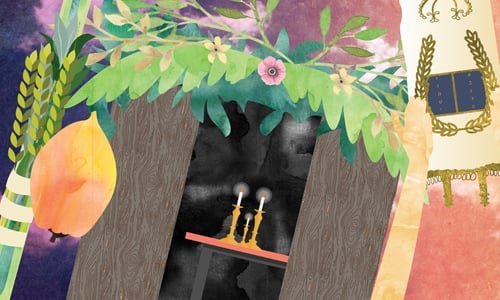As the vibrant hues of autumn surround us, we eagerly approach the enchanting weeklong celebration of Sukkot. From September 29 to October 6, 2023, our community will come together to revel in the spirit of Sukkot, a joyous Jewish holiday that holds deep significance in our tradition.
Dwelling in the Sukkah
At the heart of Sukkot is the experience of dwelling in the sukkah, a foliage-covered booth that symbolises the protection bestowed upon the children of Israel during their exodus from Egypt. Whether you choose to purchase a prefabricated sukkah or craft one yourself, there are a few essential rules to keep in mind. The sukkah, with at least three walls and a roof of unprocessed natural vegetation, becomes a home under the open sky. It’s a space where we share meals and reflect on the blessings of the harvest season.
The goal during Sukkot is to spend as much time as possible in the sukkah, immersing ourselves in its symbolism. Chabad tradition encourages us to eat all meals, especially the festive ones, in the sukkah, reciting a special blessing before doing so.
Taking the Four Kinds
A unique Sukkot observance involves taking the Four Kinds: an etrog (citron), a lulav (palm frond), three hadassim (myrtle twigs), and two aravot (willow twigs). These symbolic elements represent the diverse personalities within the community of Israel. Each day, except for Shabbat, we hold the lulav and recite a blessing that emphasises the sanctification of this commandment.
Candle Lighting and Festive Meals
The first two days of Sukkot, classified as yom tov, are marked by candle lighting in the sukkah before the festive meals. We gather under the stars, saying blessings that express gratitude for the occasion and the joy of coming together as a community.
Festive meals in the sukkah are a delightful affair, commencing with Kiddush over wine and the breaking of bread. The sukkah blessing and special holiday insertions in the Grace After Meals enhance the sacredness of these shared moments.
Hoshanot and Hoshanah Rabbah
Throughout Sukkot, we engage in the recitation of Hallel, praising the Almighty with the Four Kinds in hand. Hoshanot, alphabetically arranged prayers for Divine assistance, accompany the circling of the bimah. Hoshanah Rabbah, the seventh day of Sukkot, holds particular significance as we finalize our destinies for the coming year.
Water and Joy
Sukkot is a time when G‑d determines the amount of rain that will fall in the coming winter. While the Temple ritual involved wine libations, Sukkot featured a unique water-pouring ceremony, celebrated with music, dance, and singing. Today, our community continues the tradition with nightly celebrations, fostering joy and unity.
Shemini Atzeret / Simchat Torah: Even More Joy
The culmination of Sukkot leads us to Shemini Atzeret and Simchat Torah. Shemini Atzeret, an independent holiday in many respects, is marked by a doubled eighth day in the diaspora. Simchat Torah, the “Torah Celebration,” is a day of exuberant singing and dancing, as we conclude and immediately begin the annual Torah reading cycle.
As we bid farewell to the spiritual roller coaster of Sukkot and Simchat Torah, let us convert this inspiration into a locomotive propelling us toward greater growth, learning, and devotion in the year ahead.
Wishing you a joyous and fulfilling Sukkot celebration!



